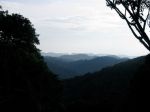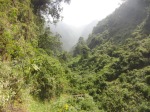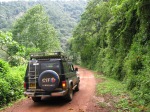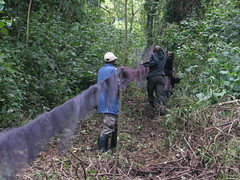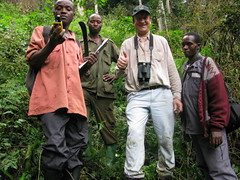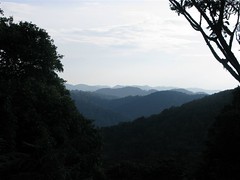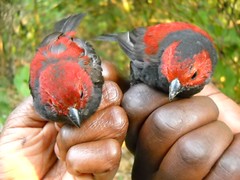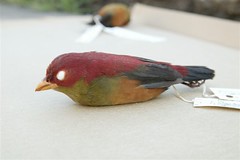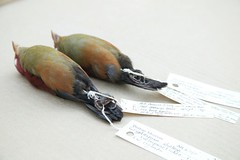-
What is Africa’s most elusive bird species ? By Dr.Chris Lotz
When asked the question “what is Africa’s most elusive bird species”, most birders would answer that it must be any of the flufftails, which are, of course, notorious. Or, perhaps they might answer that it could be one of the two pitta species lurking on this continent. But, given a systematic approach, it is actually quite possible to find and even photograph every single flufftail species given a few weeks of travel across Africa and Madagascar. Even the Critically Endangered Slender-billed Flufftail can be reliably seen with a bit of effort – As for the pittas, they certainly aren’t in any way easy, but we usually do find both species annually – our success rate for African Pitta in Mozambique and Green-breasted Pitta in Uganda must be about four in five attempts. At the start of the breeding season, we have exact stakeouts for these jewel-like species and so we’ve kind of “mastered” them and they no longer escape us.
Fewer birders would guess that the bird that we simply can’t find is a splendidly-colored finch occurring at extremely low densities in a tiny part of central Africa.
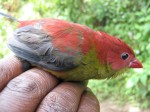
Shelley’s crimsonwing. Photo courtesy http://www.gorilla.org
While local birding guides in Uganda report the species every couple of years, there are only three known photos of the bird in the world. ( All are held in the hands of a field researcher and all are cock birds. There are currently no known photo references of a hen bird ) And we have never found one on any of our tours yet (despite the fact that we do marvelously well on all the other rare and localized species in the region). The finch we are talking about is the Shelley’s Crimsonwing (Cryptospiza shelleyi), an Albertine Rift Valley endemic with a total world population estimated at anything between 2500 and 10000 individuals.
The Albertine Rift is a westward branch of the famous Great Rift Valley, and it boasts a large number of endemic bird species occurring only in a tiny part of Africa where four countries meet: Uganda, Rwanda, Burundi and the Democratic Republic of the Congo (DRC).
The beautiful and spectacularly bio-diverse, forested mountains of the Albertine Rift straddle the border regions of these four countries. Shelley’s Crimsonwing is one of these Albertine Rift endemics skulking in the undergrowth of the mountain forests here. The DRC is a dangerous place to visit, and most birders focus on either Rwanda or Uganda when they want to find this rare finch. (But find the bird they don’t…!)
Classified as Vulnerable by Birdlife International, Shelley’s Crimsonwing is so poorly-known that scientists do not even have much of an understanding why it is so rare, and why it is apparently declining (also with very fluctuating numbers from year to year). The guess is that habitat destruction by humans is the main culprit, but it has also often been said that the species might be declining due to natural causes, albeit mysterious and puzzling ones!
Where to look for it:
- We wish we knew!
- However, it is known (among other places) from the following legendary birding forests (all of which are also famous for mountain gorilla trekking
-
-
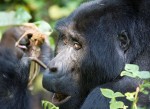
Threatened Mountain Gorilla ( Gorilla beringei.beringei ) photo taken by Cheryl Mares and kindly donated to the RFCG
Nyungwe Forest in Rwanda
- The Mgahinga Gorilla Reserve straddling the border between Uganda, Rwanda and the DRC – this is often considered a top site within Uganda for the crimsonwing, but the reserve is often inexplicably ignored by many birding tour operators. But, we do visit this site annually, partly because it is one of the most accessible sites for the incomparable Rwenzori Turaco (which we reliably DO find, unlike the crimsonwing!). With the spectacular Virunga Volcanos as a backdrop, Mgahinga is certainly not an unpleasant place to spend a couple of days…!
-
- Bwindi Impenetrable Forest in Uganda – this is where several sightings over the last few years have been, including a nesting pair that gave a good number of birders a look (practically “twitchable”) – but one also has to understand the story might have been exaggerated like a fishing tale (no photos were taken!). The long walk down to Mubwindi Swamp at the Ruhizha section of Bwindi – compulsory for seeing another of Africa’s most desirable birds, African Green Broadbill – is probably best. The good news about Bwindi is there are no less than 43 finch species that can be seen in this tropical rain forest.
Why not join us in August 2016 to help look for Africa’s most elusive finch ? Only a few places left.
Day 1: Aug 22. Arrival at Kigali in Rwanda and drive to Kisoro in Uganda stay at Travelers Rest X4 nights.
Day 2: Aug 23 Birding Mgahinga.
Birding Mgahinga Gorilla Reserve. This is one of the classic sites for Shelley’s Crimsonwing but even though we’re spending three full days here and two full days at its other classic site, we guess that the chances of actually finding Shelley’s is perhaps one in four. Hopefully the spectacular Rwenzori Turaco and the great scenery (ancient volcanos) will entertain us regardless. And, with lots of luck, who knows we might even encounter gorillas which freely cross the nearby borders into the DRC and Rwanda as this reserve straddles three countries! Please note that the main aim of this expedition is to try and find and photograph Shelley’s Crimsonwing so we’ll very much spend the bulk of our time looking for this mega-elusive species – this means driving to the reserve each morning and walking a lot, sometimes uphill quite a lot (at both sites, Mgahinga and also Bwindi).
Day 3: Aug 24 Birding Mgahinga
Day 4: Aug 25 Birding Mgahinga
Day 5: Aug 26 Birding to Ruhija.
Ruhija in the famed Bwindi Impenetrable Forest boasts over 20 Albertine Rift endemics including African Green Broadbill – and of course good old Shelley’s. If we don’t find Shelley’s, there are three other crimsonwings in this forest. It’s also one of the world’s best-known sites for Mountain Gorilla, but if you want to see that then we suggest you join the Aug 1-19 birding and primate trip – as the current trip is a “hardcore” Shelley’s trip.
Overnight at Trekkers Tavern. Ruhija. Bwindi
Day 6: Aug 27 Birding in Ruhija. Overnight at Trekkers Tavern
Day 7: Aug 28 Birding in Ruhija.Overnight at Trekkers Tavern
Day 8: Aug 29 Transfer to Kigali and departure.
The cost is based on basic clean accommodation and meals, land cruiser vehicle with driver and fuel, guide fees, park entrance fees and drinking water in the car.
The land cruiser upon which the prices are based is the typical East African one with a popup roof, but not the newest one – and without air conditioning. This is the norm in Uganda. A surcharge would be payable for a truly good vehicle.
US$3738 per person sharing for a group of 4-5 paying participants, or $3230 for 6. There will be a small single supplement for those preferring a single room or if we can’t find someone to share a room with you. A separate price can be quoted if a Gorilla trek needs to be included.
This price includes a 10 % conservation donation to the Rare Finch Conservation Group which is a registered non-profit organisation.
We would like to try and get photos and sound recordings of the Shelley’s finch, one of Africa’s rarest finches. We plan to be as close as possible to the sites we feel are best for the species. We’d like to try and get publicity for this rare species (which will hopefully help its conservation). The trip will naturally also look at other bird and finch species in the area, but our main focus will be to try and find and see the threatened and elusive Shelley’s.
Take advantage of one of two great Africa EcoTour options linked to the Shelley’s Expedition
Join a birding and primate tour of Uganda from 1 -19 August before the Shelley’s Expedition starts, and / or join a Namibia, Botswana, Vic Falls tour after it. ( Maximum 8 per group ) Details of both trips are at ihttp://birdingecotours.com/tour/birding-tour-uganda-gorillas-and-chimpanzees-in-12-days-2015-2?type=country&where=Uganda and / or http://birdingecotours.com/tour/birding-tour-namibia-okavango-and-victoria-falls-18-day-2016. please note that while the latter trip is usually run later in the year, if we get at least four participants, we will add another departure of this trip from Sep 1-18, 2016.
Please e-mail info@birdingecotours.co.za for more details on the Shelley’s Expedition and the exciting two Birding Ecotour options to experience and enjoy Africa at its very best

Founded in 2005 The Rare Finch Conservation Group is registered in South Africa as a non-profit organisation. It is totally dependent on donors and sponsors to carry out its conservation work on finches. All donations will be publicly acknowledged , unless otherwise requested, on the RFCG website. Donations can be made to the following account. Rare Finch Conservation Group, Nedbank. Account number 1933 198885 Branch : Sandown 193 305 South Africa ( For international donors please add ) SWIFT NEDSZAJJ.SEE – CONSERVE – ENJOY
Only a few places left on the expedition to help search for Africa’s most elusive finch
22 DecSHELLEY NEEDS YOUR HELP Exciting Shelley’s Expedition planned. Linked to two great Africa Ecotour Safari options
21 Oct-
Searching for Africa’s most elusive bird. By Dr.Chris Lotz
When asked the question “what is Africa’s most elusive bird species”, most birders would answer that it must be any of the flufftails, which are, of course, notorious. Or, perhaps they might answer that it could be one of the two pitta species lurking on this continent. But, given a systematic approach, it is actually quite possible to find and even photograph every single flufftail species given a few weeks of travel across Africa and Madagascar. Even the Critically Endangered Slender-billed Flufftail can be reliably seen with a bit of effort – As for the pittas, they certainly aren’t in any way easy, but we usually do find both species annually – our success rate for African Pitta in Mozambique and Green-breasted Pitta in Uganda must be about four in five attempts. At the start of the breeding season, we have exact stakeouts for these jewel-like species and so we’ve kind of “mastered” them and they no longer escape us.
Fewer birders would guess that the bird that we simply can’t find is a splendidly-colored finch occurring at extremely low densities in a tiny part of central Africa.

Shelley’s crimsonwing. Photo courtesy http://www.gorilla.org
While local birding guides in Uganda report the species every couple of years, there are only three known photos of the bird in the world. ( All are held in the hands of a field researcher and all are cock birds. There are currently no known photo references of a hen bird ) And we have never found one on any of our tours yet (despite the fact that we do marvelously well on all the other rare and localized species in the region). The finch we are talking about is the Shelley’s Crimsonwing (Cryptospiza shelleyi), an Albertine Rift Valley endemic with a total world population estimated at anything between 2500 and 10000 individuals.
The Albertine Rift is a westward branch of the famous Great Rift Valley, and it boasts a large number of endemic bird species occurring only in a tiny part of Africa where four countries meet: Uganda, Rwanda, Burundi and the Democratic Republic of the Congo (DRC).
The beautiful and spectacularly bio-diverse, forested mountains of the Albertine Rift straddle the border regions of these four countries. Shelley’s Crimsonwing is one of these Albertine Rift endemics skulking in the undergrowth of the mountain forests here. The DRC is a dangerous place to visit, and most birders focus on either Rwanda or Uganda when they want to find this rare finch. (But find the bird they don’t…!)
Classified as Vulnerable by Birdlife International, Shelley’s Crimsonwing is so poorly-known that scientists do not even have much of an understanding why it is so rare, and why it is apparently declining (also with very fluctuating numbers from year to year). The guess is that habitat destruction by humans is the main culprit, but it has also often been said that the species might be declining due to natural causes, albeit mysterious and puzzling ones!
Where to look for it:
- We wish we knew!
- However, it is known (among other places) from the following legendary birding forests (all of which are also famous for mountain gorilla trekking
-
-

Threatened Mountain Gorilla ( Gorilla beringei.beringei ) photo taken by Cheryl Mares and kindly donated to the RFCG
Nyungwe Forest in Rwanda
- The Mgahinga Gorilla Reserve straddling the border between Uganda, Rwanda and the DRC – this is often considered a top site within Uganda for the crimsonwing, but the reserve is often inexplicably ignored by many birding tour operators. But, we do visit this site annually, partly because it is one of the most accessible sites for the incomparable Rwenzori Turaco (which we reliably DO find, unlike the crimsonwing!). With the spectacular Virunga Volcanos as a backdrop, Mgahinga is certainly not an unpleasant place to spend a couple of days…!
-
- Bwindi Impenetrable Forest in Uganda – this is where several sightings over the last few years have been, including a nesting pair that gave a good number of birders a look (practically “twitchable”) – but one also has to understand the story might have been exaggerated like a fishing tale (no photos were taken!). The long walk down to Mubwindi Swamp at the Ruhizha section of Bwindi – compulsory for seeing another of Africa’s most desirable birds, African Green Broadbill – is probably best. The good news about Bwindi is there are no less than 43 finch species that can be seen in this tropical rain forest.
SHELLEY NEEDS YOUR HELP. Why not join us in August 2016 to help look for it ?
Day 1: Aug 22. Arrival at Kigali in Rwanda and drive to Kisoro in Uganda stay at Travelers Rest X4 nights.
Day 2: Aug 23 Birding Mgahinga.
Birding Mgahinga Gorilla Reserve. This is one of the classic sites for Shelley’s Crimsonwing but even though we’re spending three full days here and two full days at its other classic site, we guess that the chances of actually finding Shelley’s is perhaps one in four. Hopefully the spectacular Rwenzori Turaco and the great scenery (ancient volcanos) will entertain us regardless. And, with lots of luck, who knows we might even encounter gorillas which freely cross the nearby borders into the DRC and Rwanda as this reserve straddles three countries! Please note that the main aim of this expedition is to try and find and photograph Shelley’s Crimsonwing so we’ll very much spend the bulk of our time looking for this mega-elusive species – this means driving to the reserve each morning and walking a lot, sometimes uphill quite a lot (at both sites, Mgahinga and also Bwindi).
Day 3: Aug 24 Birding Mgahinga
Day 4: Aug 25 Birding Mgahinga
Day 5: Aug 26 Birding to Ruhija.
Ruhija in the famed Bwindi Impenetrable Forest boasts over 20 Albertine Rift endemics including African Green Broadbill – and of course good old Shelley’s. If we don’t find Shelley’s, there are three other crimsonwings in this forest. It’s also one of the world’s best-known sites for Mountain Gorilla, but if you want to see that then we suggest you join the Aug 1-19 birding and primate trip – as the current trip is a “hardcore” Shelley’s trip.
Overnight at Trekkers Tavern. Ruhija. Bwindi
Day 6: Aug 27 Birding in Ruhija. Overnight at Trekkers Tavern
Day 7: Aug 28 Birding in Ruhija.Overnight at Trekkers Tavern
Day 8: Aug 29 Transfer to Kigali and departure.
The cost is based on basic clean accommodation and meals, land cruiser vehicle with driver and fuel, guide fees, park entrance fees and drinking water in the car.
The land cruiser upon which the prices are based is the typical East African one with a popup roof, but not the newest one – and without air conditioning. This is the norm in Uganda. A surcharge would be payable for a truly good vehicle.
US$3738 per person sharing for a group of 4-5 paying participants, or $3230 for 6. There will be a small single supplement for those preferring a single room or if we can’t find someone to share a room with you. A separate price can be quoted if a Gorilla trek needs to be included.
This price includes a 10 % conservation donation to the Rare Finch Conservation Group which is a registered non-profit organisation.
We would like to try and get photos and sound recordings of the Shelley’s finch, one of Africa’s rarest finches. We plan to be as close as possible to the sites we feel are best for the species. We’d like to try and get publicity for this rare species (which will hopefully help its conservation). The trip will naturally also look at other bird and finch species in the area, but our main focus will be to try and find and see the threatened and elusive Shelley’s.
More about the two great Africa EcoTour options linked to the exciting Shelley’s Expedition experience
Join a birding and primate tour of Uganda from 1 -19 August before the Shelley’s Expedition starts, and / or join a Namibia, Botswana, Vic Falls tour after it. ( Maximum 8 per group ) Details of both trips are at ihttp://birdingecotours.com/tour/birding-tour-uganda-gorillas-and-chimpanzees-in-12-days-2015-2?type=country&where=Uganda and / or http://birdingecotours.com/tour/birding-tour-namibia-okavango-and-victoria-falls-18-day-2016. please note that while the latter trip is usually run later in the year, if we get at least four participants, we will add another departure of this trip from Sep 1-18, 2016.
Please e-mail info@birdingecotours.co.za for more details on the Shelley’s Expedition and the exciting two Birding Ecotour options to experience and enjoy Africa at its very best

Founded in 2005 The Rare Finch Conservation Group is registered in South Africa as a non-profit organisation. It is totally dependent on donors and sponsors to carry out its conservation work on finches. All donations will be publicly acknowledged , unless otherwise requested, on the RFCG website. Donations can be made to the following account. Rare Finch Conservation Group, Nedbank. Account number 1933 198885 Branch : Sandown 193 305 South Africa ( For international donors please add ) SWIFT NEDSZAJJ. -
SEE – CONSERVE – ENJOY
Maybe the Shelley’s can also help change things for the good
20 Mar
By now most of our supporters know that the threatened and elusive Shelley’s crimsonwing is found in Rwanda, Burundi, DRC and Uganda. Back in 1979 when Sir David Attenburough returned to England from a trip to Rwanda he and a group of pioneering conservationists set up the Mountain Gorilla Project and as they say the rest is history.
The natural habitat where both the threatened mountain gorillas and the elusive shelley’s crimsonwing reside is extremely lush and virtually anything that the locals may wish to plant will grow. Given this temptation , as seen in the informative above YouTube video clip, it is extremely important for the Rare Finch Conservation Group ( RFCG ) to help educate the locals, on the value of EcoTourism to protect their environment for future generations.
Part of the vision of the RFCG is to promote the Bwindi Impenetrable Forest in Uganda , with its 43 finch species which includes the threatened Shelley’s crimsonwing finch, as the world’s top destination for finch enthusiasts.
The RFCG strongly believes in upskilling the local community wherever it is possible and creating a new EcoTour industry for finch enthusiasts is part of that vision. In August the RFCG will be taking its first group of seven guests from Australia to Bwindi. All profits generated from the trip will be donated to the Rare Finch Conservation Group to further the research work needed on the threatened Shelley’s crimsonwing finch that desperately needs attention.
For more information on the pioneering conservation work that the RFCG is doing please contact editor@avitalk.co.za or visit our website at http://www.rarefinch.co.za
The Institute of Tropical Forest Conservation at Bwindi shares its exciting new vision with us
11 Mar
Listen to what Miriam van Heist from the Institute of Tropical Forest Conservation ( ITFC ) has to say in the above YouTube video clip about their exciting new vision . Part of the vision of the Rare Finch Conservation Group ( RFCG ) is to promote the Bwindi Impenetrable Forest in Uganda , with its 43 finch species which includes the threatened and elusive Shelley’s crimsonwing finch, as the world’s top destination for finch enthusiasts.
In August the RFCG will be taking its first group of seven guests from Australia to Bwindi and already some of the group members are taking special lessons on wildlife bird photography to ensure that they can enjoy the trip to its absolute maximum. All profits from the trip will be donated to the Rare Finch Conservation Group which is registered as a non-profit organisation.
The RFCG believes in upskilling the local community at Bwindi wherever it is possible and creating a new EcoTour industry for finch enthusiasts is part of that vision .
For more information on the pioneering conservation work that the RFCG is doing please contact editor@avitalk.co.za or visit our website at http://www.rarefinch.co.za
43 finch species at Bwindi. Can you believe it…
9 Nov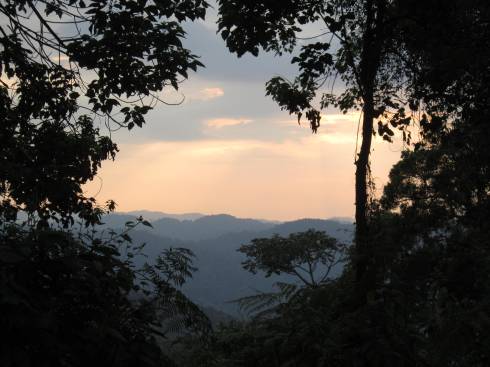
Bwindi Impenetrable Forest, Uganda. Home to 43 finch species and 380 of the world's last remaining Mountain Gorilla's. Photo taken by Russell Kingston
Following on our recent announcement on the planned 2012 RFCG EcoTour to South Africa and Uganda we have had several requests to list all the 43 finch species that can be seen at Bwindi in Uganda.
The Bwindi Impenetrable National Park is only 331 square kilometers ( 126 square miles ) in size and for many years it has been famous for not only its magnificent scenery and its rich and varied ecosystem , but also for the fact that 380 of the world’s last remaining Mountain Gorilla’s can be found in this beautiful tropical rain forest. It is one of the most important forests in Africa, it has more than 350 bird species , 310 butterfly species , 324 tree species , 120 species of mammals of which 10 species are primates .
Today thanks to the exposure that the Rare Finch Conservation Group has given to the area more and more bird enthusiasts are becoming aware of the fact that no less than 43 finch species have been sighted and recorded in the forest . This is probably the highest variety of finch species that can be seen anywhere in the world . Below is the list of finches that have been seen in the forest .
PLOCEIDAE : Weavers,etc…
Grosbeak Weaver Amblyospiza albfrons
Yellow Bishop Eupletes capensis
Red-headed Malimbe Malimus rubricollis
Strange Weaver Ploceus alienus
Baglafecht Weaver Ploceus baglafecht
Brown-capped Weaver Ploceus insignis
Black-billed Weaver Ploceus nigerrimus
Veillot’s Black Weaver Ploceus nigerrimus
Black-necked Weaver Ploceus nigricollis
Compact Weaver Ploceus superciliosus
Yellow-mantled Weaver Ploceus tricolor
Holub’s Golden Weaver Ploceus xanthops
Grey-headed Sparrow Passer griseus
Red-billed Firefinch Lagonosticta senegala
Village Indigobird Vidua chalybeata
Pin-tailed Whydah Vidua macrou
ESTRILDIDAE : Waxbills, etc…
Dusky Twinspot Euschistospiza cinereovinacea
Dusky Crimsonwing Cryptospiza jacksoni
Red-faced Crimsonwing Cryptospiza reichenovii
Abyssinian Crimsonwing Cryptospiza salvadori
Shelley’s Crimsonwing Cryptospiza shelleyi
Common Waxbill Estrilda astrild
Black-headed Waxbill Estrilda atricapilla
Yellow-bellied Waxbill Estrilda quartinia
Black-crowned Waxbill Estrilda nonnula
Green-backed Twinspot Mandingoa nitidula
White-collared Olive-back Nesocharis ansorgei
Grey-headed Negrofinch Nigrita canicapilla
White-breasted Negrofinch Nigrita fusconota
Red-fronted Antpecker Parmoptila woodhousei
Red-headed Bluebill Spermophaga ruficapilla
Black and White Mannikin Lonchura bicolor
Bronze Mannikin Lonchura cucullata
FRINGILLIDAE : Buntings, Canaries , Seed-eaters
Golden-breasted Bunting Emberiza flaviventris
Cinnamon-breasted Rock Bunting Emberiza tahapisa
Oriole Finch Linurgus olivaceus
Yellow-rumped Seed-eater Serinus reichenowi
Thick-billed Seed-eater Serinus burtoni
Yellow-crowned Canary Serinus canicollis
Yellow-fronted Canary Serinus mozambicus
African Citril Serinus citrinelloides
Streaky Seed-eater Serinus striolatus
Brimstone Canary Serinus sulphuratus
Hopefully with time more and more finch enthusiasts, from all over the world , will visit the Bwindi Impenetrable Forest and when doing so will provide valuable ecotourist employment for Uganda and the local communities living on the edge of the forest


